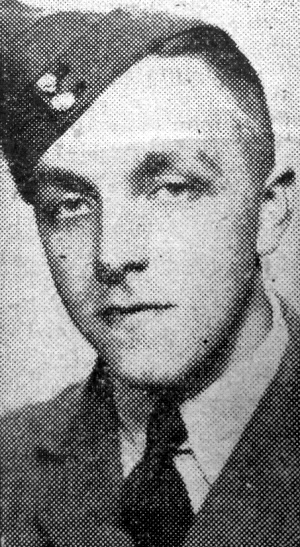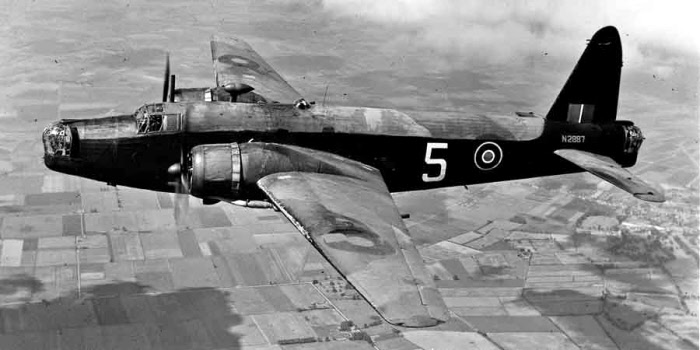
Cyril Taylor was born in early 1923, the son of Mr. Joe Taylor and his wife Victoria Carlton, who were married at St. Peter’s and St Leonard’s Church, Horbury on the 6th April 1912. Both were 24 years of age. Joe, was a miner of Horbury Junction, and Victoria worked as a weaver, living at Horbury.
In 1911, Joe was living at Perseverance Cottage, Horbury Junction with his parents and seven surviving siblings: five brothers and two sisters. In the same year Victoria, a worsted mill worker and one of eleven surviving children was living with her parents at 29, Club Houses, Horbury. Cyril was the youngest of three brothers born to Joe and Victoria Taylor. Alwyn Carlton Taylor was born in 1917 and Charles Edmund Taylor was born in 1919, all in Horbury. All three brothers served during WW2, with the two eldest Taylor brothers serving in the Royal Navy and Cyril Taylor in the Royal Air Force.
In September 1939, Cyril’s mother, Victoria, a married woman, was living at 111, Westfield Road, Horbury with her son, Charles Edmund, born on the 2nd February 1919, a printer’s apprentice. Cyril’s father, Joe, is not in the household but, as a miner, he may have been elsewhere seeking work. A third name in the household is redacted and this may be Cyril, the youngest son and, at that time, sixteen years of age.
Cyril Taylor volunteered for RAF service in January 1941 and eventually, after his initial training, became a wireless operator / air gunner with the Royal Canadian Air Force 429 (Bison) Squadron, which was formed at R.A.F. East Moor, a few miles north of York on the 7th November 1942. At that time, 429 Squadron were flying Vickers Wellington Mk III bombers as part of No. 6 Group, operating by night over Europe.
Sergeant Cyril Taylor was one of the crew of Flight Sergeant A.F. Halstead’s Wellington X bomber, HE913, AL-L, scheduled for an attack on Duisburg, the largest inland port in Germany, on the night of the 12/13th May 1943. In total 572 bombers participated in the raid that night, of which 35 were lost.
Perhaps, as Wellington HE913 lifted off from East Moor at 23:50 hours on that late Spring night, Sergeant Cyril Taylor must have felt a little bit apprehensive and perhaps a little bit confident, for he had already completed several operational flights over occupied Europe. There was an extra navigator crew member on board HE913 that night, probably as part of an operational training flight.
Their target was the industrial area around the port and the Thyssen Steel Works at Duisburg. The weather was clear that night and as the bombers came in at 13 – 20,000ft, they had no problems seeing their targets. 70,000 lbs of high explosive bombs and 153,000lbs of incendiaries were dumped on Duisburg, destroying four of the Thyssen Krupps steelworks, 21 barges in the harbour and 18,921 tonnes of shipping with another 60 vessels considerably damaged. Sadly, 1,600 houses were destroyed and 273 German civilians were killed in the raid.
Unusually, for an R.C.A.F. Squadron, the five man crew of Wellington HE913 were all English, apart from Canadian Air Gunner Douglas Broughton, as follows:
On their way back, after completing the bombing raid, at 02:58 on the 13th May, Wellington HE913 was involved in a dogfight with a German night fighter and crashed, burning into farmland 2 kilometres south-west of Asten (Noord Brabant), in Holland. All of the crew perished and were first buried at Venio before being transferred to the Jonkerbos War Cemetery at Nijmegen.
The “Ossett Observer” had this report about Sergeant Taylor being reported missing:1
“Horbury Sergeant Missing – Mr. and Mrs. Joe Taylor, 111, Westfield Road, Horbury, received a telegram on Thursday night announcing that their youngest son, Sergeant Cyril Taylor (20), R.A.F., was missing as a result of an air operation. He was educated at St. Peter’s School, Horbury and continued his education at Ossett Grammar School. He entered the service of the West Riding Treasurer’s Department at the office in Wellington Road, Dewsbury. He volunteered service in the RAF in January 1941, and is an observer. Whilst stationed in Plymouth, during a ‘blitz’, an enemy bomb dropped on the building in which he was quartered, and he escaped with a wound in the left leg. A keen footballer, he played for Ossett Grammar School, Outwood Stormcocks and Horbury Juniors. He was a member of the choir at St. Peter’s.”
Sergeant Cyril Taylor Cyril Taylor, died on 12th May 1943 and was originally buried at Venlo British Cemetery. Some of the British men, including Cyril, who lay there were moved to Jonkerbos War cemetery, some 65 km distant, and reburied in grave reference 16. D. 7 on the 8th September 1947.
The Netherlands fell to the Germans in May 1940 and was not re-entered by Allied forces until September 1944. Nijmegen was a front line town from the 17th September 1944 until February 1945.
The cemetery, which was created by No. 3 Casualty Clearing station, is in a wooded area known as Jonkers Bosch, from which it took its name. Jonkerbos War Cemetery contains 1,629 Commonwealth burials of the Second World War, 99 of them unidentified, and 13 war graves of other nationalities.

Above: Wellington Bomber like the one flown in by Sergeant Cyril Taylor of Horbury.
References:
1. “Ossett Observer”, Saturday, May 15th 1943.